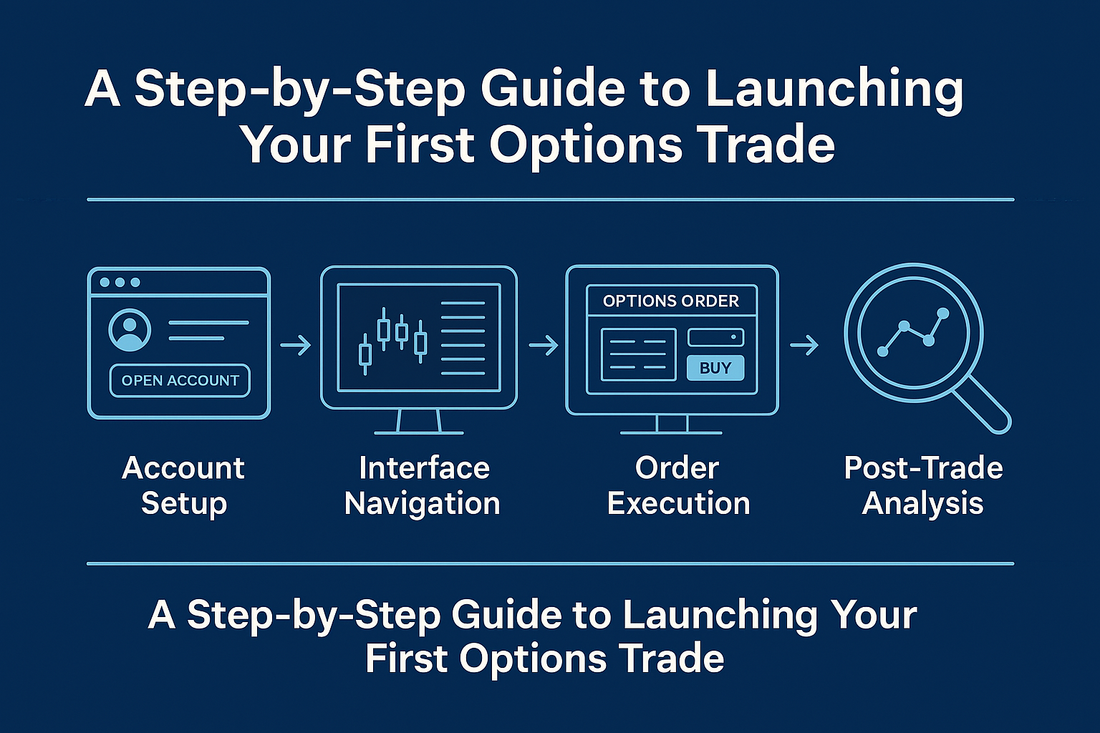
A Step-by-Step Guide to Launching Your First Options Trade: From Zero to Execution
Keywords: how to start options trading, beginner options guide, launching your first trade, options account setup, options trade walkthrough, first options trade tutorial
💡 Introduction: From Curiosity to Confidence
Every successful options trader remembers placing their very first trade—it’s the leap from theory to action, and often the start of a life-changing journey toward financial independence.
But let’s be real: launching your first options trade can feel overwhelming. From navigating broker platforms to decoding strike prices, the jargon and complexity can be intimidating. That’s why this guide was written—to take the fear out and put the power in.
By the end of this article, you’ll walk away knowing:
- How to set up your brokerage account
- How to navigate a trading interface
- How to place your first options trade step-by-step
- How to track and learn from your results
Let’s break down every part of the process so you can trade with purpose and clarity from day one.
🔧 Section 1: Account Setup – Building the Foundation
🏦 Step 1: Choose the Right Broker
To place options trades, you need a brokerage that:
- Offers options trading approval
- Has intuitive tools (charting, Greeks, analysis)
- Supports mobile and desktop access
- Provides access to education and support
📌 Popular beginner-friendly brokers:
- Thinkorswim (TD Ameritrade)
- Tastytrade
- Interactive Brokers
- Webull
📌 Singapore-based brokerages:
- Tiger Brokers – MAS-regulated, beginner-friendly, excellent mobile interface with real-time data and options support
- Moomoo (by FUTU) – Also MAS-regulated, offers advanced charting, options chains, and educational tools tailored to new traders
- Saxo Markets – Comprehensive multi-asset platform with robust options analytics and institutional-grade tools
Each has its strengths, so compare platforms to see which fits your trading style.
✍️ Step 2: Apply for Options Trading Permission
When creating or upgrading your account, you’ll be asked to:
- Answer questions about your trading experience
- Choose your trading level (from Level 1 to Level 5)
- Agree to margin or cash account terms
Options Levels usually dictate what you can trade:
|
Level |
Permission |
|
1 |
Covered calls, protective puts |
|
2 |
Long calls and puts |
|
3 |
Spreads |
|
4 |
Naked options (advanced) |
|
5 |
Complex multi-leg trades (pro only) |
📌 Start with Level 2, then scale up as your skills improve.
🔐 Step 3: Fund Your Account
Transfer funds via:
- Bank wire
- ACH
- FAST or PayNow (in SG-based brokers)
Minimum funding depends on the broker, but $500–$2,000 is a good starting range for beginners using basic strategies like long calls, puts, and spreads.
💻 Section 2: Interface Navigation – Getting Comfortable with the Platform
🐽 Dashboard Tour
Once inside your broker platform, familiarize yourself with:
|
Section |
Purpose |
|
Watchlist |
Track your favorite stocks (e.g., AAPL) |
|
Trade tab |
Where you input and execute orders |
|
Option chain |
View available strikes, expiration dates |
|
Charting |
Analyze technical levels, trends |
|
Greeks panel |
Understand delta, theta, gamma, vega |
📌 Pro Tip: Practice navigating your platform in paper trading mode first.
🔎 Understanding the Option Chain
This is where most new traders get confused, but it’s simple once you break it down.
|
Column |
Meaning |
|
Strike |
Price level of the option |
|
Bid |
Price buyers are willing to pay |
|
Ask |
Price sellers want to receive |
|
IV |
Implied volatility |
|
Delta |
Probability the option finishes ITM |
|
Volume / OI |
Activity and liquidity metrics |
📌 Choose strikes close to the current stock price for more balanced trades.
📆 Tools for Analysis
Most platforms let you:
- View historical IV and volatility rank
- Simulate profit/loss curves
- Use technical indicators to guide timing
- Compare multiple expirations
📌 Use indicators like RSI or MACD to confirm entry levels for directional trades.
📦 Section 3: Order Execution – Placing Your First Real Options Trade
✍️ Step-by-Step: A Simple Bullish Trade (Buying a Call)
Let’s walk through a basic trade—buying a call option on Apple (AAPL).
✅ Step 1: Choose a stock
Pick a stock with:
- High liquidity
- Clear trend or upcoming catalyst
- Decent IV (not too high or low)
📌 Example: AAPL trading at $170
✅ Step 2: Go to the Option Chain
Select:
- Expiration: Choose 30–45 days out
- Strike price: Pick a call 1–2 strikes OTM (e.g., $175)
✅ Step 3: Place the Order
Choose:
- Buy to open 1 contract of AAPL 175 Call
- Price: Limit order at $2.50
- Review: Risk $250 total (1 contract = 100 shares)
Click Confirm & Send
✅ Order Types Cheat Sheet
|
Order Type |
Description |
|
Limit |
Set your own price (recommended) |
|
Market |
Fills instantly at current price |
|
Stop-Limit |
Triggers at a certain price |
|
GTC |
Good 'Til Cancelled order |
📉 Section 4: Managing and Closing Your Trade
⏳ Monitor Your Position
Track:
- Current value
- Profit/loss
- Time decay (theta)
- Delta (if directional)
❌ Exiting Your Trade
Exit before expiration by:
- Selling to close your position
- Rolling the option to a different strike/date
- Letting it expire (not recommended)
📌 Rule of thumb: Close trades at 50% gain or loss.
↻ Rolling a Trade
Instead of closing:
- Roll to later expiration
- Roll to different strike
- Use as adjustment (e.g., turn losing call into spread)
🧐 Section 5: Post-Trade Analysis – Learning from Every Trade
📓 Create a Trade Journal
Track:
- Entry and exit prices
- Why you entered
- What went right/wrong
- Market context
- Greeks at entry
🧪 Example Journal Entry
|
Field |
Details |
|
Ticker |
AAPL |
|
Strategy |
Long call |
|
Entry |
Buy 175c at $2.50 |
|
Exit |
Sell at $3.50 |
|
Result |
+$100 |
|
Lesson |
RSI bounce, take profit sooner |
🧪 Build Feedback Loops
After every 5–10 trades:
- Review win rate
- Avg gain/loss
- Strategy effectiveness
- Emotional control
🧰 Trade Flowchart

❌ Mistakes to Avoid
- Trading too big
- Using market orders
- Ignoring the Greeks
- Not understanding expiration
- Skipping post-trade review
📊 Bonus: First Trades to Try
|
Strategy |
Use Case |
Risk Profile |
|
Long call |
Bullish outlook |
Limited risk |
|
Long put |
Bearish outlook |
Limited risk |
|
Vertical spread |
Range or trend play |
Defined risk |
|
Covered call |
Income on stock held |
Low risk |
|
Cash-secured put |
Entry at discount |
Moderate risk |
🚀 Final Word: Your First Trade Is Just the Beginning
Launching your first options trade marks a turning point. You’re no longer just studying—you’re taking action.
Follow this system:
- Learn your tools
- Place with purpose
- Record every move
- Reflect and grow
✅ Ready to Start Trading With Confidence?
At www.optionstranglers.com.sg we offer:
- ✅ In-depth live 1-1 sessions / group classes
- ✅ Trade examples and breakdowns
- ✅ Community mentorship and support
👉 Ready to upgrade your strategy and trade like a pro?
Visit www.optionstranglers.com.sg and start your journey to financial freedom today.
Your future is an option. Choose wisely.
⚠️ Disclaimer:
Options involve risk and are not suitable for all investors. Always consult with a financial advisor before investing.
